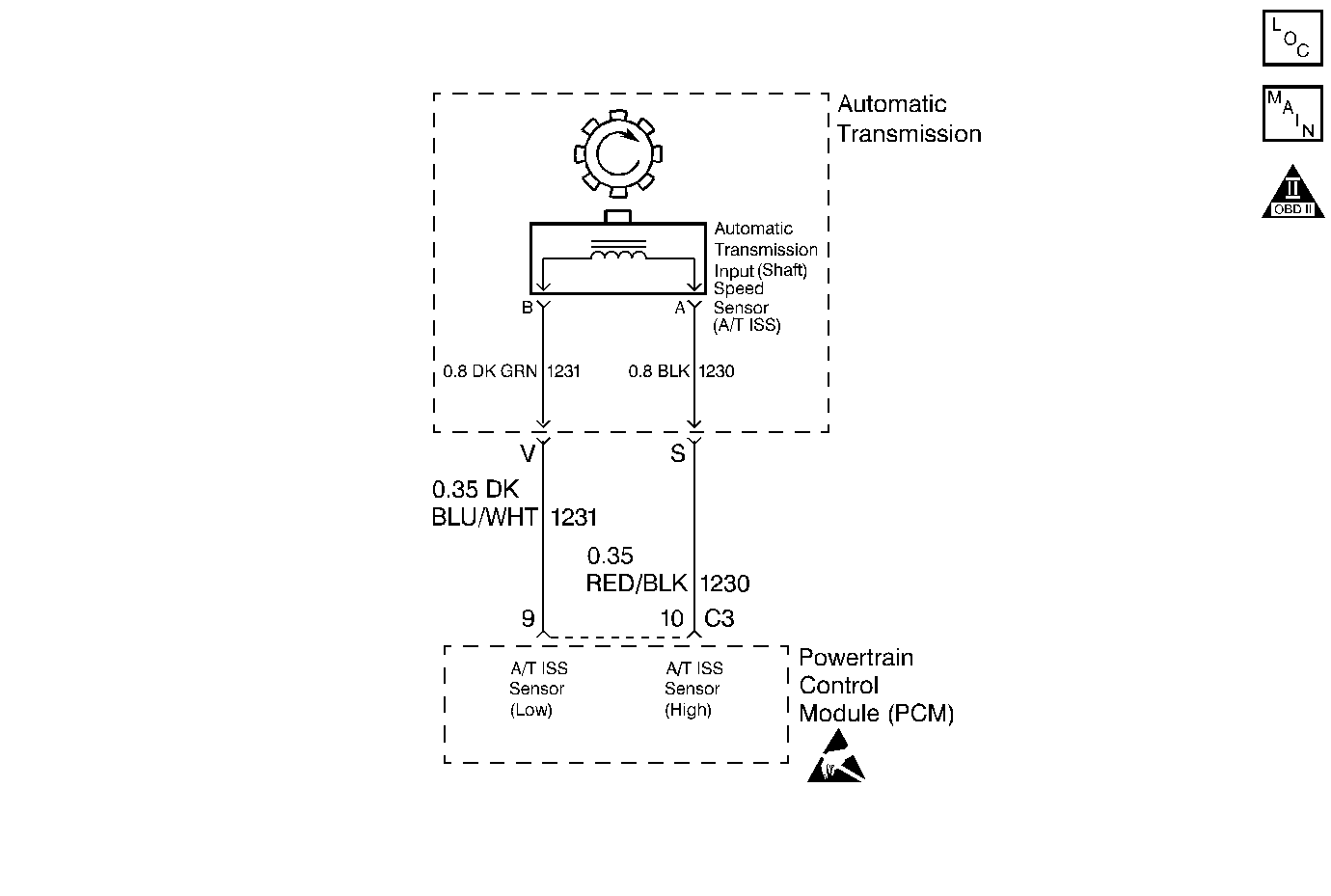
Circuit Description
The Automatic Transmission Input (Shaft) Speed Sensor (A/T ISS) provides transmission input speed to the Powertrain Control Module (PCM). The A/T ISS is Permanent Magnet (PM) generator. The sensor mounts into the transmission case and maintains a slight air gap between the sensor and the drive sprocket. The PM generator produces an AC voltage as the drive sprocket rotor teeth pass through the sensor's magnetic field. The AC voltage level increases as the turbine shaft speed increases. The PCM converts the AC voltage into a digital signal. The PCM determines actual turbine speed using the digital signal. The PCM uses the input speed to calculate torque converter slip speed, and gear ratios.
When the PCM detects an unreasonably large change in the input speed, the DTC P0716 sets. DTC P0716 is a type A DTC.
Conditions for Setting the DTC
| • | The input speed changes by more than 1300 RPM in 0.3 seconds. |
| • | No Input Speed Sensor DTC P0717 |
| • | No TP Sensor DTCs P0121, P0122, or P0123 |
| • | No VSS DTC P0502 |
| • | No 1-2 SS Valve DTCs P0751 or P0753 |
| • | No 2-3 SS Valve DTCs P0756 or P0758 |
| • | The Throttle Position (TP) is greater than 15%. |
| • | The vehicle speed is greater than 12 km/h (7 mph). |
Action Taken When the DTC Sets
| • | The PCM illuminates the Malfunction Indicator Lamp (MIL). |
| • | DTC P0716 is stored in the PCM history. |
| • | The PCM inhibits TCC engagement. |
| • | The PCM freezes shift adapts from being updated. |
| • | The PCM commands maximum line pressure. |
Conditions for Clearing the MIL/DTC
| • | The PCM turns OFF the MIL after three consecutive ignition cycles without a failure reported. |
| • | A scan tool can clear the DTC from the PCM history. The PCM clears the DTC from the PCM history if the vehicle completes 40 warm-up cycles without a failure reported. |
| • | The PCM cancels the DTC default actions when the fault no longer exists and the ignition is OFF long enough in order to power down the PCM. |
Diagnostic Aids
| • | If the engine is running and the vehicle is moving above 12 km/h (7 mph), then the input speed must be non-zero. |
| • | Inspect the wiring for poor electrical connections at the PCM. Inspect the wiring for poor electrical connections at the transmission 20-way connector. Look for the following conditions: |
| - | A bent terminal |
| - | A backed out terminal |
| - | A damaged terminal |
| - | Poor terminal tension |
| - | A chafed wire |
| - | A broken wire inside the insulation |
| • | When diagnosing for an intermittent short or open condition, massage the wiring harness while watching the test equipment for a change. |
Test Description
The numbers below refer to the Step numbers on the diagnostic table.
-
This Step tests the A/T ISS Sensor for correct resistance.
-
This Step verifies the wiring from the Automatic Transmission 20-way connector to the PCM, and tests the ability of the A/T ISS Sensor to produce an AC current.
Step | Action | Value(s) | Yes | No | ||||||
|---|---|---|---|---|---|---|---|---|---|---|
1 | Was the Powertrain On-Board Diagnostic (OBD) System Check performed? | -- | Go to | |||||||
2 |
Important: Before clearing the DTCs, use the scan tool in order to record the Freeze Frame and Failure Records for reference. The Clear Info function will erase the data. Is the transmission input speed greater than the specified value? | 500 RPM | Go to Diagnostic Aids | |||||||
Is the resistance within the specified range? | 615-835ohms | |||||||||
4 | Inspect circuit 1230 from the Automatic Transmission 20-way connector to the Automatic Transmission Input (Shaft) Speed (A/T ISS) Sensor for an open or short to ground. Refer to Troubleshooting Procedures, Section 8. Did you find and correct the condition? | -- | ||||||||
5 | Inspect circuit 1231 from the Automatic Transmission 20-way connector to the A/T ISS Sensor for an open or short to ground. Refer to Troubleshooting Procedures, Section 8. Did you find and correct the condition? | |||||||||
6 | Replace the A/T ISS Sensor. Refer to Automatic Transmission Input (Shaft) Speed Sensor Replacement, in On-Vehicle Service. Is the replacement complete? | -- | -- | |||||||
Is the AC voltage greater than the specified value? | 0.150 mV (50 Hz) | |||||||||
8 | Inspect circuit 1230 from the engine 20-way connector to the PCM connector for an open or short to ground. | |||||||||
9 | Inspect circuit 1231 from the engine 20-way connector to the PCM connector for an open or short to ground. | |||||||||
10 | Replace the PCM. Refer to Section 6: Powertrain Control Module/EEPROM Replacement/Programming (2.2L) Powertrain Control Module/EEPROM Replacement/Programming (2.4L) Is the replacement complete? | -- | -- | |||||||
11 |
In order to verify your repair, perform the following procedure:
Has the test run and passed? | -- | System OK |
